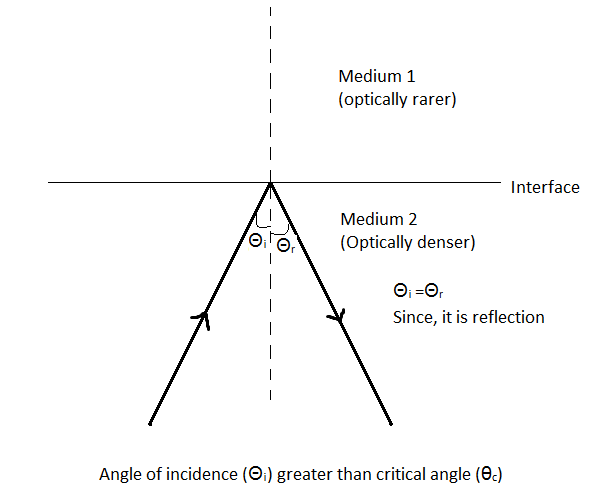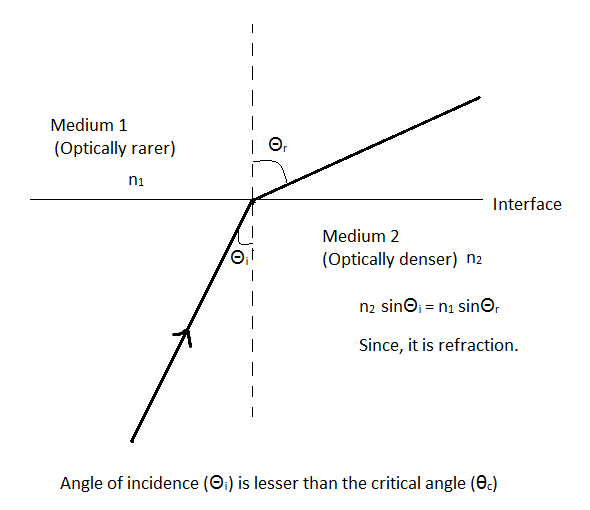
For a total internal reflection, which of the following is correct?
A. Light travels from rarer to denser medium
B. Light travels from denser to rarer medium
C. Light travels in air only
D. Light travels in water only
Answer
585.6k+ views
Hint: When light travels from an optically denser to an optically rarer medium, the angle of refraction is greater than the angle of incidence and keeps on increasing as the angle of incidence is increased.
Complete step by step answer:
Total Internal reflection (TIR) is the phenomenon in which light travels from an optically denser to an optically rarer medium but is reflected back into the denser medium at the interface.
This happens when the angle of incidence passes a certain angle known as the
Critical angle (θc). The critical angle is given by
${{\theta }_{c}}={{\sin }^{-1}}\dfrac{{{\mu }_{1}}}{{{\mu }_{2}}}$
Where 1 and 2 are the optical densities or refractive indices of the optically rarer and optically denser medium respectively.
In this case the whole of the incident ray is completely reflected back into the medium i.e. 100%. There is no refracted ray.


Additional information:
Total internal reflection causes the sparkling effect in a diamond. The diamond craftsman crafts the diamond in a way such as to give the contours angles which cause an incident angle more than the critical angle of the diamond (about 250). The light undergoes multiple total internal reflections inside the diamond giving it a dazzling look. However, unpolished, uncarved diamonds do not shine in this manner. It is the skill of the craftsmen that makes it possible.
Note: Students can make a mistake in the formula for critical angle confusing which optical density should be written as the numerator and which as the denominator.
To aid in remembering this, it should be noted that since the value of the sine function is always lesser than 1, the optical density of the rarer medium should be written as the numerator, so as to make it a fraction less than 1.
Complete step by step answer:
Total Internal reflection (TIR) is the phenomenon in which light travels from an optically denser to an optically rarer medium but is reflected back into the denser medium at the interface.
This happens when the angle of incidence passes a certain angle known as the
Critical angle (θc). The critical angle is given by
${{\theta }_{c}}={{\sin }^{-1}}\dfrac{{{\mu }_{1}}}{{{\mu }_{2}}}$
Where 1 and 2 are the optical densities or refractive indices of the optically rarer and optically denser medium respectively.
In this case the whole of the incident ray is completely reflected back into the medium i.e. 100%. There is no refracted ray.


Additional information:
Total internal reflection causes the sparkling effect in a diamond. The diamond craftsman crafts the diamond in a way such as to give the contours angles which cause an incident angle more than the critical angle of the diamond (about 250). The light undergoes multiple total internal reflections inside the diamond giving it a dazzling look. However, unpolished, uncarved diamonds do not shine in this manner. It is the skill of the craftsmen that makes it possible.
Note: Students can make a mistake in the formula for critical angle confusing which optical density should be written as the numerator and which as the denominator.
To aid in remembering this, it should be noted that since the value of the sine function is always lesser than 1, the optical density of the rarer medium should be written as the numerator, so as to make it a fraction less than 1.
Recently Updated Pages
Master Class 12 Business Studies: Engaging Questions & Answers for Success

Master Class 12 Economics: Engaging Questions & Answers for Success

Master Class 12 English: Engaging Questions & Answers for Success

Master Class 12 Maths: Engaging Questions & Answers for Success

Master Class 12 Social Science: Engaging Questions & Answers for Success

Master Class 12 Chemistry: Engaging Questions & Answers for Success

Trending doubts
What are the major means of transport Explain each class 12 social science CBSE

Which are the Top 10 Largest Countries of the World?

Draw a labelled sketch of the human eye class 12 physics CBSE

How much time does it take to bleed after eating p class 12 biology CBSE

Explain sex determination in humans with line diag class 12 biology CBSE

Differentiate between homogeneous and heterogeneous class 12 chemistry CBSE




